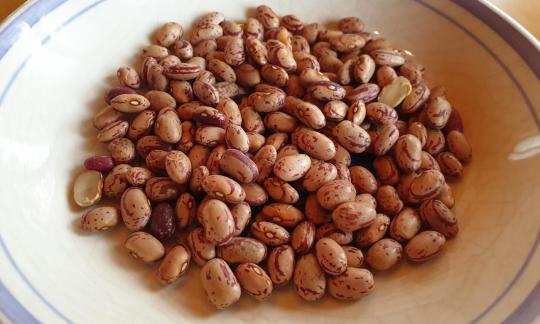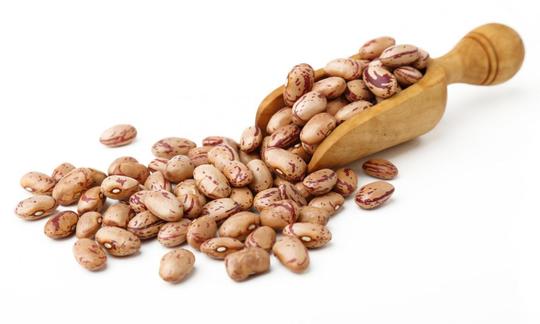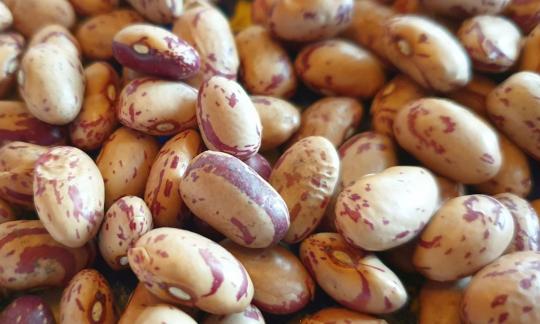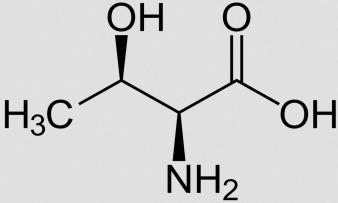Table of contents
The red-speckled borlotti beans , also known as cranberry beans , originally come from South America. Like other legumes, they are good for the heart and circulation and promote a feeling of satiety.
Use in the kitchen
Why do you have to cook beans? Freshly harvested, ripe borlotti beans are used cooked. Dried beans are soaked in water for a few hours before cooking. However, beans are poisonous when raw (fresh or dried but uncooked).
Borlotti beans are very popular in Italy. They are a common ingredient in salads, but are also suitable for making soups and stews - such as the well-known minestrone. Borlotti beans can also be used to make a hearty bean pie (bean paste) or a vegan pasta sauce. The mild borlotti bean is also highly valued in Turkish and Greek cuisine.
During the cooking process, the borlotti beans lose their red-brown to magenta-like marbling and take on a light reddish color. The size and texture are reminiscent of kidney beans ; the taste is the same, but the borlotti is a bit nuttier. Dried borlotti beans and pinto beans look very similar, which is why the latter are considered an ideal borlotti bean substitute.
Your own preparation
The correct way to prepare dried borlotti beans: soak them overnight in water (just enough to cover them), pour off the remaining water the next morning and rinse the beans. Cook them in fresh water, without salt , at a low heat until the beans are soft. Pour off the water before processing or eating.
On the one hand, it is recommended to rinse the beans thoroughly after cooking in order to get rid of the dissolved gaseous substances. 17 On the other hand, this also means that important vitamins (including folic acid ) are lost. Spices such as caraway , marjoram, cumin , asafoetida ( Ferula assa-foetida ), fennel , coriander or aniseed help to improve digestibility.
Raw borlotti beans and pinto beans can be sprouted if you buy them raw. After about 3-4 days, the sprouted beans and their sprouts are edible raw. You can find more information on sprouting pulses, grains or nuts here .
Vegan recipe for borlotti bean patties
Ingredients (for 8 patties): 125 g organic borlotti beans, dried (or approx. 290 g cooked beans); 1 tbsp oil ( rapeseed oil ); 1 small onion ; 1 medium carrot (raw); 1 tsp nutritional yeast ; marjoram ; 35 g breadcrumbs (vegan); salt andpepper .
Preparation: Soak the beans in water overnight, drain the water the next day, rinse the beans and cook in fresh water until they are done. Finely chop the onion and sauté in a pan with 1 tablespoon of oil. Peel the carrot and finely grate it. After the beans have cooled, chop them in a food processor or with a potato masher and mix them with the diced onion and grated carrot. Add yeast flakes, marjoram, a little salt and freshly ground pepper for seasoning. Then mix in the breadcrumbs, form patties from the mixture with wet hands and fry slowly in the pan.
Alternative: You can also use pinto beans or other beans for this vegan borlotti beans recipe.
Salads with Borlotti Beans
Cooked borlotti beans combine well with raw ingredients such as onions, rocket or radicchio , diced tomatoes or celery . They go well with pressed garlic , lemon juice , fresh oregano , chili peppers and parsley .
Vegan recipes with borlotti beans can be found under the note: " Recipes that have the most of this ingredient ".
| Not only vegans or vegetarians should read this: Vegans often eat unhealthily. Avoidable nutritional mistakes . |
Purchasing - Storage
Borlotti beans are usually available as so-called pal beans (ie bean seeds that have been ripened in the bean pod and then removed from it). Pal beans can be bought fresh, dried or cooked, in a can, in a jar or in a tetra pack - even in organic quality. Borlotti beans from a can should always be rinsed well with clean water before consumption and make sure that they do not contain any preservatives.
Organically grown borlotti beans can be bought from major retailers such as Coop or Rewe , in drugstores, organic food stores and online. In stores such as Migros , Spar , Billa , Edeka , Hofer , Denn's Biomarkt or Alnatura, please ask about the current range. Supermarkets such as Denner , Volg , Aldi and Lidl may also occasionally have borlotti beans on offer.
You can find fresh borlotti beans in their shells at local weekly markets during the season. As so-called bush beans or runner beans, they are in season in mid-July . Depending on the location, you can buy ripe borlotti beans from August to the end of October .
Many products lose vitamins due to sterilization, which is why you should prefer to prepare them yourself using a gentle method. When shopping, make sure that the beans are organic and, if possible, buy them fresh or dried.
The availability of Borlotti beans varies depending on the size of the store, catchment area, etc. If you are interested, click on our recorded food prices for the DA-CH countries (above under the ingredient image). There you will find current prices from various supermarkets and their price development.
Storage tips:
Green borlotti beans do not stay fresh for very long, max. 2-3 days in the vegetable compartment of the refrigerator. If you have larger quantities, you can freeze the cooked bean seeds. Once they are fully ripe, dried and stored in a dark, cool place, they can be stored for years.
Ingredients - Nutritional values - Calories
Raw boletus beans (cranberry beans) have 335 kcal/100g and are a valuable source of protein with 23 g/100g (46.1% of the daily requirement). The carbohydrate content is very high at 60 g/100g and the daily requirement is covered with 25 g of fiber per 100 g. There is hardly any fat (1.2 g/100g).
Folate, a folic acid-active substance group, is found in higher doses in raw pulses (raw borlotti beans have 604 µg/100g = 302% of the daily requirement). As folate is a B vitamin, it is water-soluble and sensitive to light and oxygen, similar to vitamin C. How much folic acid is left in beans after they have been prepared? According to a study by the Federal Research Institute for Nutrition in Stuttgart, the folic acid content (in green beans and green peas) is reduced by around 25% when steamed and by up to 50% when boiled. Therefore, gentle preparation is very important. 13 As an example, here are kidney beans, ripe seeds, raw : The folic acid content of 394 µg/100g is reduced to 130 µg/100g when boiled (without salt) .
The protein composition of borlotti beans is very favorable because they contain many valuable amino acids, especially the really essential threonine (0.97 g/100g, 104% of the daily requirement) and lysine (1.6 g/100g, 85% of the daily requirement).
Borlotti beans have a favorable ratio between the healthy omega-3 fatty acid ( alpha-linolenic acid, ALA ) and the inflammation-promoting omega-6 fatty acid ( linoleic acid, LA ) (1:1). However, compared to other beans such as soybeans (ripe seeds: 1.3 g/100g, but with a worse LA 5:1 ALA ratio) and top performers such as linseed (23 g/100g), chia seeds (18 g) or walnuts (9.1 g), borlotti beans (0.24 g) contain very little of the healthy alpha-linolenic acid.
The complete ingredients of borlotti beans, the coverage of the daily requirement and comparison values with other ingredients can be found in our nutrient tables. In the article Nutrients explained you will get a detailed insight into the topic.
Effects on health
Borlotti beans are considered healthy and very suitable for diabetics, 6 because their carbohydrates are absorbed very slowly into the blood and thus keep blood sugar levels constant. They have a so-called low GI (glycemic index). They are also said to have a cholesterol-lowering effect. 3
Results of an American study published in the Archives of Internal Medicine show a lower risk of heart disease with increased consumption of pulses. Blood pressure and heart rate also decreased significantly. 5,6
Regular consumption of beans helps to reduce the risk of colon cancer. Due to their high fiber content, beans bind water and swell. This increases stool volume and stimulates intestinal activity, which also helps against constipation. 4 Beans also promote a feeling of satiety and can thus prevent obesity.
There is also a study in the field of breast cancer prevention that assumes that the flavonoids contained in beans block free radicals and kill cancer cells. 8 Regular consumption of beans and other legumes can also reduce the risk of prostate cancer, especially if you avoid all forms of meat at the same time. 9
In addition to their anti-carcinogenic and anti-mutagenic effects, the polyphenols in beans also have antioxidant and anti-inflammatory potential. 16
Beans can also help with arteriosclerosis: their antioxidants fight free radicals before they oxidize the body's own cholesterol. Oxidized cholesterol contributes to the development of arteriosclerosis. In addition, flavonoids work against adhesions of blood platelets and fatty deposits in the arteries. 10
Folic acid is involved in important metabolic reactions (DNA and RNA synthesis). Too little can cause genetic damage. Eating foods containing folic acid, such as beans, reduces the risk of pancreatic and colon cancer. 11 However, too many artificial folic acid supplements can increase the risk of developing cancer. 12
Dangers - Intolerances - Side effects
Many beans contain harmful lectins when raw, which have a negative effect on our health when consumed. The main active ingredient that causes toxicity is toxalbumin phasin, which belongs to the lectins. Toxic lectins in legumes can be rendered harmless by heating (at least 15 minutes) or soaking and germinating. 21 Read more about this in the article on phytic acid .
The oligosaccharides contained in the legumes are not soluble for the body's own intestinal enzymes. However, the intestinal bacteria can break down the raffinose and stachyose through bacterial fermentation, producing gases as a byproduct. The development of intestinal gases (flatulence) can vary depending on the bacterial colonization of the large intestine. 1 People who are sensitive to this should not eat beans in the evening.
To reduce flatulence, it is worth soaking the raw beans overnight before cooking and discarding the soaking water. 17 In the case of gastrointestinal intolerance to oligosaccharides, it is possible to take the enzyme α-galactosidase, 14,17 which breaks down raffinose into sucrose and galactose, orally. A small double-blind crossover study on 19 subjects showed positive results in at least some patients. 14 Nevertheless, we do not recommend taking this enzyme as a dietary supplement (α-galactosidase A, also known as melibidase) without medical advice or as a preventative measure, as it can also cause severe dizziness, itching, rashes or breathing difficulties.
Spices - as mentioned above: anise, fennel, caraway , etc. - have carminative effects. They are said to have a relaxing effect on the intestinal muscles. This makes flatulence easier for adults and especially for small children.
Ecological footprint - animal welfare
Pulses such as peas , beans and lentils are considered a natural meat substitute due to their high protein content. This has been the case since the textbook on food chemistry by Josef Tillmans (Prof. of Chemistry, Tillmans reagent) from 1927, which shows the process of using legumes to produce meat substitutes. Consciously avoiding meat (by consuming more pulses, vegetables, seeds and nuts) can even reduce resource consumption (material footprint). 7
The ecological footprint of pulses is significantly better than that of animal protein sources. On average, six to seven times less agricultural land is needed to produce 100 g of plant protein than for 100 g of meat protein. 24 Water consumption is also lower: six times less water is needed to produce pulses than to produce the same amount of beef. 25 CO 2 emissions are also significantly lower than those of meat. According to the Institute for Energy and Environmental Research ( IFEU ), the production of one kilo of beans or peas emits around 0.8 to 1.3 kilos of CO 2 -eq; the same amount of pork emits 4.6 kg CO 2 -eq/kg, and beef as much as 13.6 kg CO 2 -eq/kg. 26 You can find more information under Basic knowledge .
Ideally, when shopping, you should look for regional , organically grown products, as organic farming does not use synthetic pesticides. In conventional farming, on the other hand, large quantities of herbicides (such as glyphosate) are used when growing pulses, and not just to control weeds. Desiccation, a practice to speed up the harvest, involves deliberately killing the crop using herbicides. This dries out the plant and the crop ripens more quickly. This is used primarily in countries where the growing season is too short (e.g. Canada), or simply as a time-saving measure. 22 Accordingly, there may also be an increased concentration of this agent in the end product, particularly in pulses or grains. 23
Worldwide occurrence - cultivation
There are various theories about the origin of the common bean (or garden bean = Phaseolus vulgaris ). It is assumed that there were two gene pools in the wild relatives, one of Mesoamerican origin (Mexico) and one in South America. This was further divided into 6 landraces; the cranberry bean is said to belong to the Chilean "race" of the Andean gene pool. 15
In Colombia, the cranberry bean is called 'Cargamanto'. In Italy, the beans were further cultivated, given a thicker shell and the sonorous name Borlotti beans (see below).
Cultivation - Harvest
Depending on how they grow, garden beans are divided into pole beans or bush beans. Borlotti beans therefore grow as pole beans with climbing aids (e.g. variety Lamon) or as bush beans (e.g. varieties Lingua di Fuoco, Borlotto Rosso).
Growing borlotti beans organically in the garden: Start them indoors and plant them out in a sunny spot outdoors after the Ice Saints without fertilizing (weak feeders) or sow them directly. Depending on whether you want to use them as bush beans (between 15 and 30 cm apart) or as pole beans (between 30 and 50 cm), press them one to three centimeters into the soil, then water the seeds and keep them moist during the germination phase. This is how you get your own organic beans. 2
As bush beans (green, with pods), Borlotti beans can be used in a similar way to green beans . The pods are green, with reddish marbling. Once the bean kernels have developed, they can be harvested when they are milky or dry.
The bean seeds are medium-sized, creamy white, and turn brownish depending on how dry they are - with red to magenta speckles. Dried beans should be left outside on the plant for as long as possible in dry weather. They should then be left to dry for at least two weeks after harvest.
Further information
What are Borlotti beans? The Borlotti bean is a variety of the common bean ( Phaseolus vulgaris ). Its name comes from the Italian expression 'fagioli borlotti', which means "round beans" in English.
All types of garden beans originate from America. Spanish and Portuguese sailors brought them to Europe in the 16th century. 20 Before the import of American garden beans, the broad bean ( Vicia faba ssp. faba var. equina ) was an important staple food in Europe, but then lost much of its popularity. Broad beans belong to the vetch genus ( Vicia ) - in contrast to garden beans ( Phaseolus ). 19
Possibility of confusion
Borlotti beans look very similar to pinto beans, which are particularly popular in the USA and Mexico and are known there as 'pinto beans'. However, these two types of beans differ in taste. Because of their color and pattern, quail beans are reminiscent of quail eggs. In Italy, the name Borlotto is used broadly, i.e. for many varieties in several colors, which does not help the uncertainty. 19
Alternative names
Borlotti beans are known by many names: The term 'Saluggia bean', for example, refers to a town called Saluggia in northern Italy, where the borlotti bean is traditionally cultivated. 19 The trade names of borlotti beans are: borlotti beans, borlotto bean (in the singular), cranberry bean and saluggia bean. Other names include Roman bean, Romano bean (not to be confused with the green, fresh 'Romano bean' known in Italy) and rosecoco bean.
Borlotti is often found in other spellings such as: Barlotti, Barlotti beans, even as Birlotti, Bolloti, Bolotti, Borlitti, Borlott etc.
In English, the borlotti bean is called either borlotti bean, cranberry bean, gadhra bean or Roman bean (saluggia bean or rosecoco bean). In Portugal it is called feijão catarino, but the same name can also refer to pinto beans.
Bibliography - 25 Sources
| 1. | Winham DM, Hutchins AM. Perceptions of flatulence from bean consumption among adults in 3 feeding studies. Nutr J. 21. November 2011;10:128. |
| 2. | Gartenjournal.net Borlotti-Bohnen im eigenen Garten anbauen. |
| 3. | Bazzano LA, Thompson AM, Tees MT, Nguyen CH, Winham DM. Non-soy legume consumption lowers cholesterol levels: A meta-analysis of randomized controlled trials. Nutrition, Metabolism and Cardiovascular Diseases. 1. Februar 2011;21(2):94–103. |
| 4. | Wakai K, Date C, Fukui M, Tamakoshi K, Watanabe Y, Hayakawa N et al. Dietary fiber and risk of colorectal cancer in the Japan collaborative cohort study. US National Library of Medicine National Institutes of Health, Pub Med. 2007 Apr, 16(4). |
| 5. | Jenkins D, Kendall C, Augustin L, et al. Effect of Legumes as Part of a Low Glycemic Index Diet on Glycemic Control and Cardiovascular Risk Factors in Type 2 Diabetes Mellitus. A Randomized Controlled Trial. Archives of Internal Medicine. 2012, 172(21). |
| 6. | Eckert N. Hülsenfrüchte - hierzulande noch unbeliebt, aber segensreich für den Typ-2-Diabetiker. Medscape. 2012 Nov. |
| 7. | Lettenmeier M, Liedtke C, Rohn H. Eight tons of material footprint - suggestion for a resource cap for household consumption in finland. Resources. 9. Juli 2014;3(3):488–515. |
| 8. | Adebamowo CA, Cho E, Sampson L, Katan MB, Spiegelman D, Willett WC, Holmes MD. Dietary flavonols and flavonol-rich foods intake and the risk of breast cancer. Int J Cancer. 2005 Apr, 20;114(4). PMID: 15609322. |
| 9. | Magee PJ, Owusu-Apenten R, McCann MJ, Gill CI, Rowland IR. Chickpea (Cicer arietinum) and other plant-derived protease inhibitor concentrates inhibit breast and prostate cancer cell proliferation in vitro. Nutr Cancer. 2012;64(5). |
| 10. | Furhman B, Aviram M. Flavonoids protect LDL from oxidation and attenuate atherosclerosis. Curr Opin Lipidol. 2001 Feb; 12(1). PMID: 11176202. |
| 11. | Duthie SJ, Narayanan S, Sharp L, Little J, Basten G, Powers H. Folate, DNA stability and colo-rectal neoplasia. Proc Nutr Soc. 2004 Nov; 63(4). PMID: 15831129. |
| 12. | Wien TN, Pike E, Wisløff T, Staff A, Smeland S, Klemp M. Cancer risk with folic acid supplements: a systematic review and meta-analysis. BMJ Open. 2012 Jan 12;2(1):e000653. |
| 13. | Bognár A. Vitaminverluste bei der Lagerung und Zubereitung von Lebensmitteln. Bundesforschungsanstalt für Ernährung. Stuttgart. Ernährung/Nutrition. 1995;19(9). |
| 14. | Ganiats TG, Norcross WA, Halverson AL, Burford PA, Palinkas LA. Does Beano prevent gas? A double-blind crossover study of oral alpha-galactosidase to treat dietary oligosaccharide intolerance. J Fam Pract. November 1994;39(5):441–5. |
| 15. | Robson D. Characterization of the Non-Darkening Gene in a Cranberry Bean (Phaseolus vulgaris L.) Background. Thesis. University of Guelph. Canada. 2017. |
| 16. | Ganesan K, Xu B. Polyphenol-rich dry common beans (Phaseolus vulgaris L.) and their health benefits. Int J Mol Sci. 4. November 2017;18(11):2331. |
| 17. | Queiroz K da S, Oliveira AC de, Helbig E et al. Soaking the Common Bean in a Domestic Preparation Reduced the Contents of Raffinose-Type Oligosaccharides but Did Not Interfere with Nutritive Value. Journal of Nutritional Science and Vitaminology. 2002;48(4): 283–289. |
| 19. | Legumichepassione.com Siehe v.a. bei den Einträgen: Lombardia; Toscana; Fagiolo Borlotto Nostrale; Fagiolo Borlotto di Maremma; Fagiolo Borlotto di Gambolò; Fagiolo di Saluggia; Fava (für die Ackerbohne). |
| 20. | Oecd.org Consensus document on the biology of common bean (Phaseolus vulgaris L.). OECD Environment, Health and Safety Publications. Series on Harmonisation of Regulatory Oversight in Biotechnology. 2015;59. |
| 21. | Bender AE. Haemagglutinins (Lectins) in Beans. Food Chemistry. 1983; 11 (4). |
| 22. | Xu J, Smith S, Smith G, Wang W, Li Y. Glyphosate contamination in grains and foods: An overview. Food Control. 2019; 106. |
| 23. | CVUA Stuttgart. Glyphosat in Obst und Gemüse - so präsent wie in den Medien? 2020. |
| 24. | WWF. Die Proteinfrage. Von pflanzlichen Alternativen bis hin zu Insekten (PDF). 2021. |
| 25. | Albert-Schweitzer Stiftung. Das steckt hinter einem Kilogramm Rindfleisch. 2016. |
| 26. | Reinhardt G, Gärtner S, Wagner T. Ökologische Fussabdrücke von Lebensmitteln und Gerichten in Deutschland. Institut für Energie- und Umweltforschung Heidelberg. 2020. |












Comments